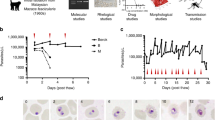Abstract
In vitro culture of asexual blood stages of Plasmodium falciparum is essential to study the parasite biology, and several aspects need to be addressed to successfully cultivate the parasites, including the requirements for red blood cells and specific nutrients. Since Trager and Jensen established the technique in 1976, some modifications have been introduced to improve the growth rate and yield. In brief, the method is based on the use of human red blood cells suspended in RPMI-1640 culture medium supplemented with a source of lipids and maintained at 37 °C in a low-oxygen atmosphere. In this protocol, a description of thawing, culturing, and cryopreservation of asexual blood stages of P. falciparum is presented.
Access this chapter
Tax calculation will be finalised at checkout
Purchases are for personal use only
Similar content being viewed by others
References
Trager W, Jensen JB (1976) Human malaria parasites in continuous culture. Science 193:673–675
Jensen JB, Trager W (1977) Plasmodium falciparum in culture: use of outdated erthrocytes and description of the candle jar method. J Parasitol 63:883–886
Wenger RH, Kurtcuoglu V, Scholz CC, Marti HH, Hoogewijs D (2015) Frequently asked questions in hypoxia research. Hypoxia 3:35–43
Duffy S, Avery VM (2018) Routine in vitro culture of Plasmodium falciparum: experimental consequences? Trends Parasitol 34:564–575
Torrentino-Madamet M, Almeras L, Desplans J, Le Priol Y, Belghazi M, Pophillat M, Fourquet P, Jammes Y, Parzy D (2011) Global response of Plasmodium falciparum to hyperoxia: a combined transcriptomic and proteomic approach. Malar J 10:4
Lambros C, Vanderberg JP (1979) Synchronization of Plasmodium falciparum erythrocytic stages in culture. J Parasitol 65:418–420
Cranmer SL, Magowan C, Liang J, Coppel RL, Cooke BM (1997) An alternative to serum for cultivation of Plasmodium falciparum in vitro. Trans R Soc Trop Med Hyg 91:363–365
Radfar A, Mendez D, Moneriz C, Linares M, Marin-Garcia P, Puyet A, Diez A, Bautista JM (2009) Synchronous culture of Plasmodium falciparum at high parasitemia levels. Nat Protoc 4:1899–1915
Ismail HA (2013) Freezing of patient isolates and strains with glycerolyte, 6th edn. MR4/ATCC
Rowe AW, Eyster E, Kellner A (1968) Liquid nitrogen preservation of red blood cells for transfusion; a low glycerol-rapid freeze procedure. Cryobiology 5:119–128
Delves MJ, Straschil U, Ruecker A, Miguel-Blanco C, Marques S, Dufour AC, Baum J, Sinden RE (2016) Routine in vitro culture of P. falciparum gametocytes to evaluate novel transmission-blocking interventions. Nat Protoc 11:1668–1680
Schuster FL (2002) Cultivation of Plasmodium spp. Clin Microbiol Rev 15:355–364
Jensen JB, Trager W (1978) Plasmodium falciparum in culture: establishment of additional strains. Am J Trop Med Hyg 27:743–746
Snounou G, Zhu X, Siripoon N, Jarra W, Thaithong S, Brown KN, Viriyakosol S (1999) Biased distribution of msp1 and msp2 allelic variants in Plasmodium falciparum populations in Thailand. Trans R Soc Trop Med Hyg 93:369–374
Sherman IW (2009) Reflections on a century of malaria biochemistry: salvage of purines. Adv Parasitol 67:1–402
WHO (2010) Basic malaria microscopy, 2nd edn. WHO, Geneva
Kirk K (2001) Membrane transport in the malaria-infected erythrocyte. Physiol Rev 81:495–537
Dluzewski AR, Ling IT, Rangachari K, Bates PA, Wilson RJ (1984) A simple method for isolating viable mature parasites of Plasmodium falciparum from cultures. Trans R Soc Trop Med Hyg 78:622–624
Goodyer ID, Johnson J, Eisenthal R, Hayes DJ (1994) Purification of mature-stage Plasmodium falciparum by gelatine flotation. Ann Trop Med Parasitol 88:209–211
Uhlemann AC, Staalsoe T, Klinkert MQ, Hviid L (2000) Analysis of Plasmodium falciparum-infected red blood cells. MACS 4:7–8
Ribaut C, Berry A, Chevalley S, Reybier K, Morlais I, Parzy D, Nepveu F, Benoit-Vical F, Valentin A (2008) Concentration and purification by magnetic separation of the erythrocytic stages of all human Plasmodium species. Malar J 7:45
Jensen MD, Conley M, Helstowski LD (1983) Culture of Plasmodium falciparum: the role of pH, glucose, and lactate. J Parasitol 69:1060–1067
Murray L, Stewart LB, Tarr SJ, Ahouidi AD, Diakite M, Amambua-Ngwa A, Conway DJ (2017) Multiplication rate variation in the human malaria parasite Plasmodium falciparum. Sci Rep 7:6436
Chou ES, Abidi SZ, Teye M, Leliwa-Sytek A, Rask TS, Cobbold SA, Tonkin-Hill GQ, Subramaniam KS, Sexton AE, Creek DJ, Daily JP, Duffy MF, Day KP (2018) A high parasite density environment induces transcriptional changes and cell death in Plasmodium falciparum blood stages. FEBS J 285:848–870
Acknowledgments
The author’s research work has been supported by the Danish International Development Agency—Danida (17-02-KU), and Lundbeck Foundation (R250-2017-1289). We thank Maiken Visti for her technical assistance; Michael Ofori (Noguchi Memorial Institute for Medical Research, University of Ghana) for blood collection; Asier García and Anne Knudsen (Faculty of Health and Medical Sciences, University of Copenhagen) for comments and suggestions.
Author information
Authors and Affiliations
Corresponding author
Editor information
Editors and Affiliations
Rights and permissions
Copyright information
© 2022 The Author(s), under exclusive license to Springer Science+Business Media, LLC, part of Springer Nature
About this protocol
Cite this protocol
Lopez-Perez, M., Seidu, Z. (2022). Establishing and Maintaining In Vitro Cultures of Asexual Blood Stages of Plasmodium falciparum. In: Jensen, A.T.R., Hviid, L. (eds) Malaria Immunology. Methods in Molecular Biology, vol 2470. Humana, New York, NY. https://doi.org/10.1007/978-1-0716-2189-9_5
Download citation
DOI: https://doi.org/10.1007/978-1-0716-2189-9_5
Published:
Publisher Name: Humana, New York, NY
Print ISBN: 978-1-0716-2188-2
Online ISBN: 978-1-0716-2189-9
eBook Packages: Springer Protocols




